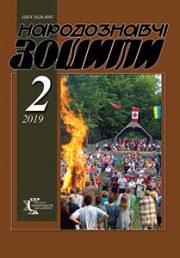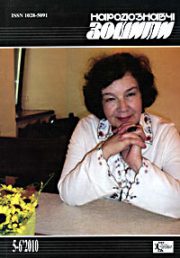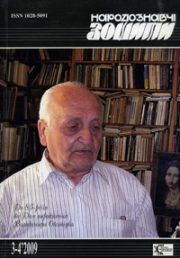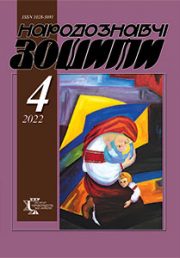The Ethnology Notebooks. 2020. № 4 (154), 770—780
UDK 746.3:2-525.4](477)”20”
DOI https://doi.org/10.15407/nz2020.04.770
TRADITIONAL DECORATIVE METHODS IN MODERN LITURGICAL FABRICS AND PRIEST’S VESTMENTS
OLIYNYK Olha
- ORCID ID: https://orcid.org/0000-0002-7292-3264
- Сandidate of Аrts (Ph. D),
- Researcher at the Folk Art Department
- of Ethnology Institute
- of the National Academy of Sciences of Ukraine
- 15, Svobody Avenue, 79000, Lviv, Ukraine,
- Contacts: e-mail: oliao1610mac@gmail.com
Abstract. Introduction. The coverage of modern ecclesiastical fabrics` artistic specifics is relevant in the context of socio-cultural dynamics, in particular, the determining the impact of traditional techniques on their decorative system, as well as the fixation of new artefacts. The artistic language of ecclesiastical embroidery, in its own turn, requires critical attention and patience. In particular, it is related to the weakening of the influence of Moscow Patriarchate artistic ideas and canons on the work of Ukrainian centres.
Article purpose consists in the analysis of the liturgical fabrics artistic features of the late XX — early XXI centuries from different centres, first Kyiv and Lviv. The author traces the role of the traditional basis on the formation of new stylistic forms in the decoration and finds out the factors and reasons for the strengthening of decorativism. She also provides material for comprehension specialists, employees of museum and exhibition institutions as well as church leaders.
The main research techniques are: a formal-analytical comparison of art works of the liturgical textiles, as well as a systematic approach and art analysis of the phenomenon.
Results. Liturgical stitching of the XXI century combines traditional form, spiritual content and composition with modern features: new iconographic subjects, variety of materials and techniques applied, stylistic experiments and the search of original art forms. Tradition is a relevant and active emotional component in the work of modern liturgical fabrics` designers, a sensual reflection of regional features.
Conclusion. Most secular and monastic workshops manufacture the items (embroidery, vestment) of an industrial nature, made on embroidery machine with software control. Indications of liturgical embroidery`s modern works are the dominance of decor above the image, when ornamental stitching suppresses the figurative, as well as the introduction of secular and folk embroidery motifs.
It is noted, that a large part of ecclesiastical embroidery centres in Ukraine is under the influence of Moscow Patriarchate artistic ideas and canons, which deprives their works of independence and originality. At the same time, it is proved, that the introduction of Ukrainian folk embroidery (geometric and floral ornaments` motifs, regional colours) in the decoration of liturgical fabrics and priest`s vestment was caused changes in their artistic language, the emergence of new meanings, including the promotion of national ideas, organically fit into the traditionally created image of the Ukrainian Church.
Keywords: aliturgical fabric, priest`s vestment, a tradition, ecclesiastical stitching, embroidery, ornament.
Received 29.05.2020
REFERENCES
- Pecheniuk, T. (1997). On the Introduction of the Issue «Liturgical Fabrics of the Christian Church» in the Curriculum of Lviv Academy of Arts. (Proceeding of the second scientific readings in memory of Mykhailo Dragan «Sacred art of Boyko Region»). Drohobych: Vidrodzhennia [in Ukrainian].
- Gridneva, Y.G. (2008). Evolution of Byzantine Tradition in the Iconography of Liturgical Stitching of the Late Middle Ages. Candidate`s thesis. Kharkiv [in Russian].
- Matveeva, Y.G. (2018). The Language of Fabrics in Byzantine Art. Kharkiv: O.M. Beketov KhNUMH [in Ukrainian].
- Shelyuto, E.M. (2005). Educational Programs at Church Artistic Stitching Department. Cover (Issue 1, pp. 17—18). St. Petersburg [in Russian].
- Fishchuk, O.V. (2007). Pre-Mongol Stitches. Cover (Issue 3, pp. 68—70). St. Petersburg [in Russian].
- Online store «UOC-TEXTILE». Retrieved from: https://upctextil.com/ (Last accessed: 20.05.2020) [in Russian].
- Art and Production Enterprise «Golden Stitching». Retrieved from: http://zolotoe-shitvo.kr.ua (Last accessed: 20.05.2020) [in Russian].
- Goldsmiths. Retrieved from: http://dkr.com.ua/index.php?new= 7645 (Last accessed: 20.05.2020) [in Russian].
- Gold Stitching Workshops in Nikolskyi (Donbass). Retrieved from: http://orthodox.donbass.com/news/201204/nik.htm (Last accessed: 20.05.2018) [in Russian].
- Holy Epiphany Kremenets Convent (UOC-MP). Retrieved from: http://arhiv.orthodoxy.org.ua/ru/krasa_pravoslav_ya/2006/01/18/223.html (Last accessed: 20.05.2020) [in Ukrainian].
- Workshop for Sewing Church Clothing «Ryza». Retrieved from: http://www.ryza.com.ua/ (Last accessed: 20.05.2020) [in Ukrainian].
- I’m Happy Because I Do What I Like. Retrieved from: http://gazeta.lviv.ua/arhiv/life/2014/11/24/36735.html (Last accessed: 20.05.2020) [in Ukrainian].







